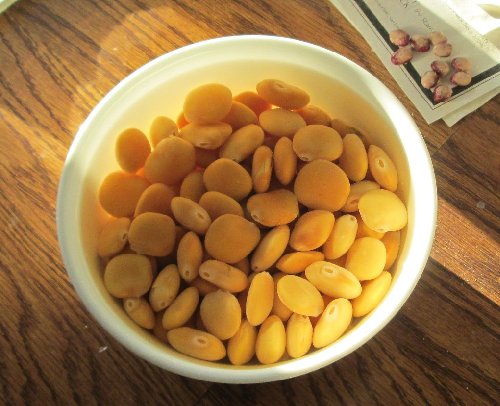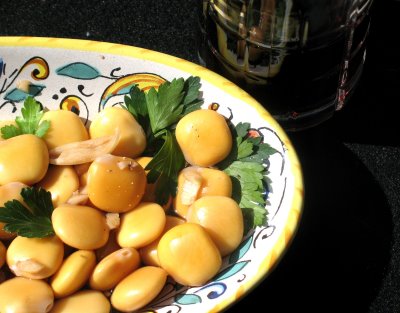|
Welcome to my Lupini Bean page!
If you are a first-timer surfing the Web for "what are these things", let
the title instill in you the proper level of caution
and respect for the Bean Of the Ancient Mediterranean Scene.
Q: I can just throw a handful of dry lupinis into a pot of water, boil them,
and they're ready to go, right?
A: NO.
Executive Summary:
To prepare,
- Cover them with salted water and soak in the fridge overnight.
- Drain the soaked beans. Boil them in 4x their volume in salted water for 3 hours,
then drain them.
- Cover with salted water in a bowl or jar and soak in the fridge overnight.
- Pour off the soaking-water and rinse the beans off.
- Repeat steps (3) and (4) daily for at least 2 weeks; 3 weeks is better.
- Marinate for a couple of weeks, if desired, with the recipe of your preference
(see below).
Background:
[First seen in Ancient Egypt; probably first tamed in Greece, 4,000+ years ago:]
"The earliest archaeological reports on lupins are referred to the XII dynasty of
Egyptian Pharaohs (over 2 thousand years BC). In their tombs, seeds of Lupinus
digitatus Forsk., already domesticated in those times, were discovered... seven seeds
of this species were also retrieved in the tombs of this dynasty dated back to the
22nd century BC. They are the most ancient evidence of lupin in the Mediterranean
(Zhukovsky, 1929)...
"The beginning of the history of lupin cultivation in the Old World is often
associated with the times of the ancient Egyptian civilization (Zhukovsky, 1929;
Maisuryan, Atabiekova, 1974; Taranukho, 1980). It is, however, more likely (Kurlovich,
1998) that originally white lupin was introduced into cultivation in ancient Greece where
its greatest biodiversity was concentrated and wild-growing forms have been preserved
until nowadays... Besides, the Grecian genesis of cultivated lupin is
testified by lupin’s Greek name “termis”, that may be translated as “ardent”. Until now,
in many countries of the world water-soaked and boiled lupin seeds are sold on markets
and in bars as delicacies (like sunflower seeds). Utilization of white lupin was probably
the same in ancient Greece."[1]
"These legumes were popular with the Romans and they spread their cultivation throughout
the Roman Empire. Today, Lupini are most commonly found in Mediterranean countries and
their former colonies, especially in Spain, Portugal, Italy, Brazil, as well as Egypt...
Syria, Lebanon, Jordan, Israel, Turkey , Chicago's Little Italy and in New York City's
Spanish Harlem, where it is popularly served with beer..." [2]
But be aware, home chefs, the little beasties are poisonous if not properly
prepared:
[They contain alkaloids that gotta be soaked out, else they will mess you up:]
"Lupin poisoning affects people that eat incorrectly prepared lupin beans.
"Mediterranean cultures prefer the historic bitter lupin beans with the required
toxin-removal by traditional leaching in water preparation methods due to the
better flavour that results. Improper preparation of bitter lupini with
insufficient soaking allows pharmacologically significant amounts of the
anticholinergic alkaloids to remain in the beans, and poisoning symptoms result.
"While the alkaloids found in raw and dried beans are bitter and unpalatable to
many, with merely insufficient soaking the level is reduced. Some people like
bitter herbs and may mistakenly prepare and eat lupini without enough soaking if
they haven't learned of its unique preparation requirements. There are several
references in medical literature to poisoning caused by errors in lupini
preparation. Dry lupini beans are rarely sold with instructions...
[Emphasis mine]
"The Italian and Portuguese tradition is to soak the beans for a week or two in a
pillowcase or fabric bag in a stream.
"Symptoms of lupin bean poisoning (from excess alkaloid in cooked food) include
dilated unresponsive pupils, confusion, slowed thought and disorientation,
flushed face and/or fever, high heart rate and blood pressure, tremors, difficulty
with or slurred speech, in-coordination, dizziness, burning dry mouth, stomach
pain, and anxiety or "malaise".[3]
Allergic to Peanuts? Be extra cautious:
"... lupin allergy is on the rise and may cause life-threatening anaphylaxis in
sensitive individuals. There is some cross-reactivity with peanut allergy, so nut
allergy sufferers should exercise extreme caution with lupin-containing food..."
[2]
So.
They are a non-trivial dish to prepare at home.
However, all is not lost if you do not have access to a clear running stream.
I, Chefcuta the Munificent, have put together a very serviceable and tasty recipe
for preparing them, out of a bit of info here, and a piece of info there.
First, ya gotta find the beans.
The best locations are where there is a large Italian diaspora, such as Chicago's
Little Italy or in the New York City area. Failing that, you can get them online.
I (my housemate, actually) got mine from Angelina's Gourmet, on
Amazon.com.
Excellently, his bottle of dry Lupinis even featured instructions! Which I incorporate
into the recipe.
Good dry lupini beans should look very much like oyster crackers-- round, and palest tan.
Discard any that are discolored, just in case.
Lupini Bean Taming Preparation Recipe:
- Cover 1 cup of beans* with salted water and soak overnight.
* For each volume of lupinis you want, use 1/3 that amount of the dry beans. So 1 cup
will make 3 cups of prepped beans. This amount fits nicely in a used 28-oz
marinara/spaghetti sauce jar.
- Bring 2 quarts of fresh (i.e. purified) water to a boil. Rinse the beans and add
them to the water, and simmer for 3 hours, until the skins are smooth.
- Cover beans with salted water in a container, and keep the container in the fridge.
Change the water once daily. Repeat this procedure for 14 days
(I recommend 2 1/2 weeks). "Mark the start time on your calendar so you don’t forget."
[4]

Batch of lupinis after 1 day of soaking.
Don't they look innocent?
But if you look closely, you can see that the water is already yellowish from the
alkaloids that have soaked out.
"It is essential to rinse the beans daily. There are bitter alkaloids in the
lupinis that are released in the water over time. You can see the rinse water
change each day from a yellow hue to clear after about two weeks.
At the two-week mark, taste one of the beans; if it’s still a bit bitter, keep
rinsing for a few more days until all the bitterness is gone." [4]
"When the beans no longer bite back:"
- Per quart jar of lupinis (and close enough for a spaghetti sauce jar), put in:
* 1 Tbsp of Salt
* ~ 1/4 tsp Whole black peppercorns (or freshly ground black pepper)
* ~ 1/2 tsp Fresh Parsley (dry flakes will do in a pinch)
* 1 clove of Garlic (or 1/2 tsp Garlic Powder)
* 1/4 cup Red Wine Vinegar
* 2 Tbsp balsamic vinegar
* Splash of Tamari (optional)
* and fill the jar the rest of the way up with water, to the top, covering the beans.
- After about 9 days of marination, the beans are ready to eat!
Barbara from Dish 'n' That blog
goes on to instruct us on how to eat the beans properly:
"Serve the lupinis in a nice bowl with a drizzle of olive oil, salt, if needed, and
freshly ground black pepper.

The art of eating lupinis at the table:
Pick up a bean and bite into the skin. Squeeze the bottom of the skin and pop the
bean into your mouth.
The skins are edible, but too fibrous to really enjoy. The inner bean is succulent
and meaty, and the essence of the salt, pepper, olive oil and vinegar come
through nicely with every bite.
Practice popping the beans into your mouth — watch for flying projectiles! You
wouldn’t want to hit someone across the table at this nice festa, now would you?"[4]
She's not kidding. The little suckers will fly like rockets when you squeeze the skin!
Sound like too much work?
There are a variety of providers who are now selling pre-prepared lupini beans in stores and online. It
appears that others have discovered the delights of lupini beans too!
Just be certain your lupini provider has properly soaked all the toxins out of them. If in doubt, or
especially, if they taste even slightly bitter, don't eat them!
"Well, heck. I'm home free with my good old red kidney beans, right?"
Not exactly.
You see, even the "ordinary" non-lupini beans we are all used to eating have a toxin of their own--
"phytohaemagglutinin".[6] Speaking from hard personal experience, this "bean toxin" will lay
you down flat. Oh, my yes. Think "projectile [X]" from both ends of you. Very miserable.
However, this phyto-whatsit-toxin is easy to remove. Just boil your (non-lupin) beans--
a full rolling boil, mind you-- for at least 30 minutes before reducing them to a simmer.[6]
My mistake was
merely simmering my beans (pretty little 'Valenas' in my case) without ever actually boiling them. This
is something that is not widely publicized, "because of course everybody boils their beans", and I had to
scour the Web to find out what had happened to me.
Similarly, lupini beans have been eaten in the Mediterranean for thousands of years, and the people there
all know that "of course you soak and rinse lupinis til the bitterness is gone." However, lupinis are new to
people in places like North America, Australia, etc, and folks there may not know the proper preparation
methods. Lupinis do need more TLC than "regular" beans to make them edible, which is why I wrote this
webpage.
[1]: History of Lupin Domestication
[2]: Wikipedia: Lupin Bean
[3]: Ask.com: Lupin Poisoning [Dead link]
[4]: Dish 'n' That blog: Lupini Beans
[6]: Phytohaemagglutinin, Wikipedia
|



